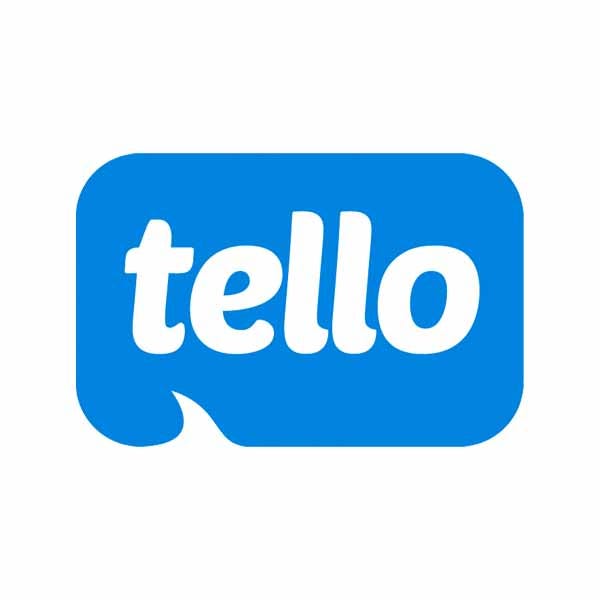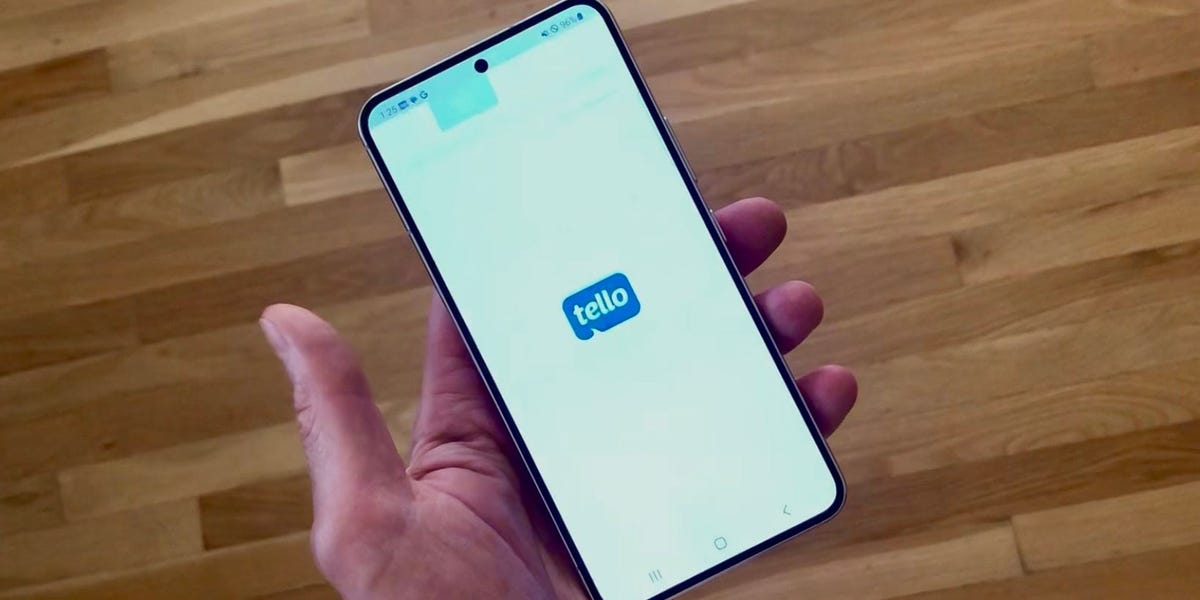When you buy through our links, Business Insider may earn an affiliate commission. Learn more
With unlimited data options, free hotspot tethering, and prices as low as $5 a month, Tello Mobile makes a strong case for those seeking a low-cost cell carrier. They operate using T-Mobile’s cell towers, like other mobile virtual network operators (or MVNOs) Mint Mobile and Google Fi Wireless, but have a different set of plan offerings that are geared toward low-data users, students, or simply those looking to save a few extra dollars a month.
Tello’s Build Your Own plan fills a niche that many big-budget carriers tend to avoid: an essentially pay-what-you-use system meant specifically for people who aren’t on their phones much — think grandparents, kids, or anyone who is most often connected to WiFi and doesn’t use a lot of data. For these users, Tello’s customizable plan provides exactly the right amount of data at the lowest possible rate, making it one of the best cheap cell phone plans available.
Ultimately, though, you get what you pay for with Tello, as the budget plan comes with barebones benefits — there aren’t discounts for multiple lines like you might see on a traditional family plan, for example, and there are no ways to use your phone’s data outside the United States.
I tested Tello’s coverage, data reliability, and speeds to see how the service fared in a typical week in New York City, considering the pros and cons of Tello’s various plans so you can judge whether Tello will work for you.

Tello Mobile (Build Your Own Plan)
Tello’s unique Build Your Own plan allows you to customize your data and minutes to your specific needs and offers a low base price of $5/month.
Plan offerings and flexibility
Tello Mobile’s strength lies in its wide selection of plan options, including a range of pre-designed plans and the opportunity to create your own customized plan.
Each plan has a designated allotment of data per month before your data speeds will be throttled to 2G from 4G LTE/5G, and any additional data you use that month will be free of charge. Even the “unlimited” data plan has this threshold, with data speeds slowing to 2G after you use 25GB of high-speed data.
All of Tello’s plans include unlimited texts, and you can choose an unlimited minutes option for calls or add prepaid minutes or data to your account using Tello’s Pay As You Go credit. The Pay As You Go minutes are a good option if you have a minutes-only plan and want the option of data usage if you need it, and your credits will last 90 days. Here are the specifics of each Tello premade plan:
*The “Unlimited” data allotment isn’t truly unlimited — after you use 25GB of 4G LTE/5G high-speed data, your data speeds will slow to 2G.
**You can’t combine the “No data” option with a “No minutes” option in a Build Your Own plan; you’ll have to couple “No data” with at least 100 minutes.
All of Tello’s plans have a data cap, which, when met, reduces users’ data speeds to 2G rather than the faster 4G LTE or 5G, but any 2G data used after that cap is free so that you won’t be left without means. You likely won’t be able to stream video or perform other high-data functions easily at that point. Still, if you regularly watch videos over data, Tello probably isn’t meant for you, regardless.
There are also a few pre-made plans directed specifically at families looking to customize individual lines on their plan. While there are no discounts for adding multiple lines to an existing plan, each line can be given its own data and minutes allotment. These are essentially specific arrangements of the Build Your Own plan and are designated as “For Grandparents,” “For Teens,” “For Students,” and “For Parents.” It’s also important to note that each line will have its own billing cycle, and each will be billed separately on the day the plan was activated rather than on a single billing date for the entire account.
The prices with Tello’s plans are impressive — costing as low as $5 a month — but the accompanying data and minutes can be difficult for some users, even with unlimited texts. If you want the lowest possible price with the Build Your Own plan, you’ll have to choose between minimum data (and zero minutes) and minimum minutes (with zero data).
If you’re a frequent social media user, tend to browse off of WiFi, or use health apps that often require data to operate, you’ll likely use the low data cap quickly and be stuck with 2G speeds for the rest of the month. However, if you don’t use your phone much or are always connected to WiFi, you could make some serious savings.
Coverage area
Since Tello operates on T-Mobile’s network, you can expect the coverage area to be the same — if T-Mobile works well in your area, it’s likely Tello will, too. Some areas in the western United States have less consistent coverage, so if you live in a more rural area out west, you might have spottier coverage. My testing area in New York City had consistently good coverage through the service, and in general, major urban centers are well-covered by T-Mobile (and, by extension, its various MVNOs, Tello included).
You can check your coverage area by entering your address or viewing the coverage map on the coverage page of Tello’s website.
Tello’s coverage is provided by T-Mobile, so if T-Mobile covers your area, you should have reliable coverage with Tello.
Tello
The downside to this is that with more users comes more network traffic, and T-Mobile prioritizes their top-paying customers over the lower-budget carriers that use their network, like Tello, Google Fi, and Mint Mobile. In those high-traffic instances, Tello users will experience slower data speeds until congestion decreases. Thus, they may be more likely to encounter a 2G connection rather than a faster 4G LTE or 5G one — even if their high-speed data allotment is not yet used up.
Service reliability and speeds
While Tello’s access to T-Mobile’s expansive network means that customers will likely be covered throughout much of the US, your data speeds may vary depending on your location.
In my own experience, I had no issues sending and receiving texts, making audio and video calls, and using social media apps while connected via 4G LTE or 5G through Tello, which is a good sign for an MVNO operating in a major metropolitan area like New York. I noted that the audio quality of phone and video calls wasn’t the best and would cut out occasionally, both on standard phone calls as well as WiFi calls. However, I had no undelivered texts or dropped calls, even when I only had a few bars of service to work with.
During my week of testing, I used Tello’s “Data” plan, which is their option for an unlimited data and minutes plan. I only used about 2GB of data throughout the week, which is far less than the plan’s 25GB data cap (after which my data speeds would have slowed to 2G rather than 4G LTE or 5G). Even calculating a month’s usage would put me under the data cap. Granted, I’m connected via WiFi the vast majority of the time (either in the office, my home, or a café, all places I’m likely to be found working most days). My usage would have skyrocketed if I’d relied solely on hotspot data.
With that in mind, Tello customers can use their mobile device as a hotspot with no additional charge, a perk many carriers will charge extra for. That said, your hotspot usage will come out of your monthly pool of data, and once you use 5GB of data through a hotspot, your hotspot speeds will slow.
While connected to my Tello hotspot, I was able to browse online and watch YouTube videos with ease, but I found that it struggled to stream 4K video on Netflix, for instance. This wasn’t necessarily surprising, as I used a hotspot rather than a stable WiFi connection. If you rely on hotspots in your preferred places of work outside the home and office or stream video frequently over data, your data allowance will be spent quickly. If you only use a hotspot occasionally, however, this perk is definitely not to be overlooked.
Tello also supports WiFi calling through the My Tello app, which you might skim over as a prospective user at first but can be a key feature for some — Tello doesn’t offer international roaming options, so you’d be stuck as a Tello user abroad without WiFi calling. It’s not ideal, but in a pinch, it works. Within the US, though, you’ll be covered as long as T-Mobile has coverage in your area. If T-Mobile is spotty for you, your data and loading speeds will likely fluctuate much more. So you might consider another budget carrier like Visible Wireless, which uses Verizon’s network and may provide more coverage where you need it.
Customer support
With Tello, your initial setup will be minimal — you’ll receive a SIM card in the mail, and that’s just about it. The QR code on the card containing the SIM directs you to download the My Tello app, which provides a little bit more setup information and a basic walkthrough of the app’s functions, and then you’re set to begin your wireless service.
Since Tello is an online-only company, there are customer support channels available through the app and by phone only (with no option to visit a brick-and-mortar store for assistance), but the 24/7 chat feature is responsive and can answer most of the basic questions you might have on setup.
You can also use the app to make calls over a WiFi connection, connect with the shop to purchase a new phone, or manage your plan preferences. The shop notably only provides phones that are mostly older or refurbished, which reflects Tello’s baseline principle of affordability and accessibility for its customer base.
If you have a newer phone, it will most likely be compatible with Tello, but you should double-check its compatibility on Tello’s website using your phone’s IMEI number.
Should you sign up for Tello Mobile?
Tello Mobile’s low-cost, low-data plans aren’t for everyone, but they could be a huge money saver for the right person. As a prospective buyer, you don’t choose Tello for its benefits, data, or even coverage, as it’s outperformed by other MVNOs like Mint Mobile and Visible Wireless on all those counts. Instead, you choose it to save money.
I was overall surprised by how well Tello served me during my testing, especially as someone who tends to use more data while out in New York. I expected to hit data deprioritization quickly by using video calls and social media, and I figured a service that costs as little as Tello’s couldn’t be all that effective.
In reality, I was able to survive perfectly well with Tello, though using the service gave me pause in moments when I might usually reach for my phone. Lower data limits can be cumbersome, but there’s undoubtedly some benefit to being able to disconnect from your device and be more present in the moment — even if it’s simply so that you don’t meet your data cap. And texts and calls work perfectly well over T-Mobile’s network, so the basics are covered in a pinch even if you do hit your data max.
The plans can be as cheap as $5 a month; even the highest-cost plan is just $25 a month. The latter isn’t necessarily the best deal for “unlimited” data, as your high-speed allotment is capped at 25GB (rather than the 30+GB offered by other MVNOs), but the cost and customization options make Tello’s Build Your Own plan one of the best cell phone plans around for its budget value — a potential steal for users who don’t use a lot of data each month and don’t want to pay for anything more than they use.
Tello’s Economy and Value plans are both less than $15 a month, and while their data allowances are 1GB and 2GB, respectively, both include unlimited talk and text. For many users, that data will run out quickly — but if you’re someone who’s most often connected via WiFi, if you don’t use your phone much at all, if you’re traveling to the US and need a phone for the duration of your stay, or if you’re a student who’s paying for their own phone plan for the first time, these plans could be a perfect fit.
Ultimately, Tello is a carrier for limited-data users. Data hogs, video streamers, and those traveling internationally from the US need not apply.

FAQs
Who owns Tello Mobile?
Tello Mobile is owned by the global telecommunications company KeepCalling.
What network does Tello Mobile use?
Tello operates using T-Mobile’s cellular network.
This means that the coverage provided by Tello is virtually the same as that provided by T-Mobile, though T-Mobile users will be prioritized in terms of data speed over Tello users.
Deprioritization will occur with any MVNO, as it’s part of the deal with using a larger carrier’s cell towers while keeping prices low for customers.
Eve Montie
Insider Reviews Tech Fellow
Eve was a former Tech Fellow with the Reviews team, focusing on consumer technology. She comes with background at a connected fitness tech startup, where she worked directly with consumers translating complex technological information into accessible, user-friendly material. She has also worked in public radio at WBUR Boston, where she produced segments on broadband internet access and smart-home technology. Prior to working at Insider, Eve has also worked in documentary film production for episodes of PBS’ American Experience, museum operations in Prague, Czech Republic, and at a Persian/French bakery in Cambridge, MA.
She double-majored in Art History and Peace and Justice Studies at Wellesley College, concentrating on visual media as it relates to representation and social activism. She was an editor for the Wellesley Review and is an Anchor Point Fellow.
Reach out to her on Twitter @eve_montie.
Read more
Read less


